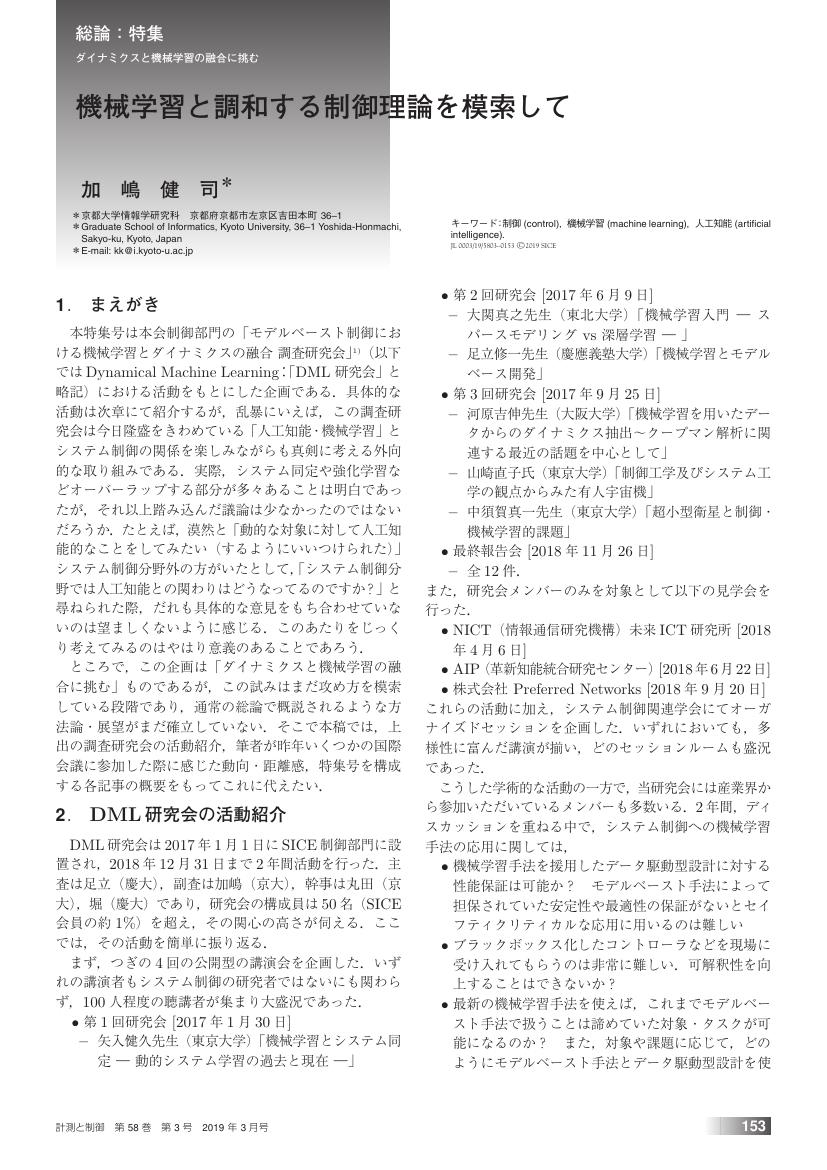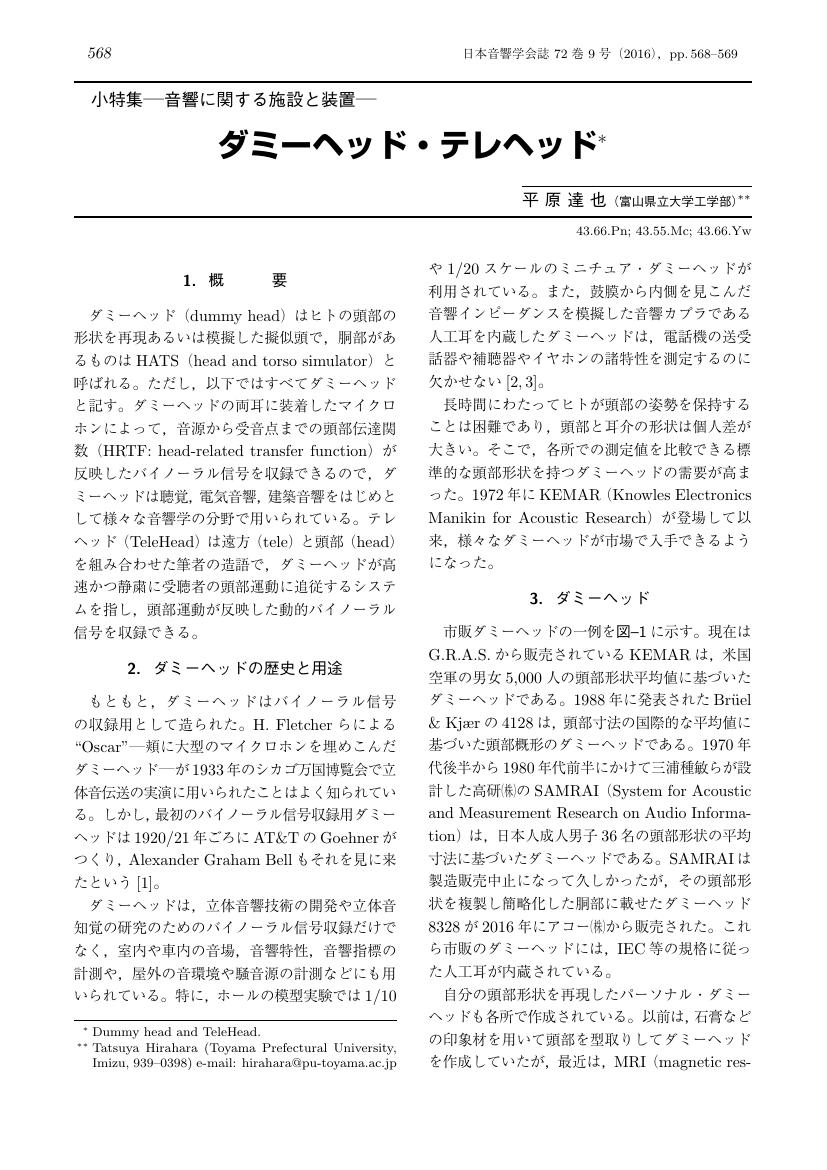14 0 0 0 OA 国鉄分割・民営化成功の神話と現実-JRによる知られざるロングシート問題からの検討
- 著者
- 武田 泉
- 出版者
- 交通権学会
- 雑誌
- 交通権 (ISSN:09125744)
- 巻号頁・発行日
- vol.1998, no.16, pp.11-25, 1998 (Released:2017-04-10)
14 0 0 0 IR 「島」の海没伝承における「神」の意味 : 高知県「戸島」・京都府「冠島」の海没伝承を中心に
- 著者
- 林 英一
- 出版者
- 獨協大学国際教養学部言語文化学科
- 雑誌
- マテシス・ウニウェルサリス (ISSN:13452770)
- 巻号頁・発行日
- vol.17, no.1, pp.1-41, 2015-11
The legend or the tradition of the island that sank in the sea is strongly related to "Kami" and is explained. Particularly, in "Heshima" of Kochi Prefecture and "Kanmurijima" of Kyoto Prefecture, an epiphany is connected with an island sinking in the sea. In "Heshima", an island sinks by intention of worshiped "Kami", and, at this time, "Kami" begins to flow, but appears again afterwards. In "Kanmurijima", "Kami" gets down on the place where an island sank in the sea, and it is considered to be ancestor assumed ancestor Kami of "Kaifu-shi", and the island comes to be recognized as "Tokoyo". In "Okameiso" of Tokushima Prefecture, the next world was conscious of to the trace which an island sank in the sea, and after all existence of "Kami" was conscious of. These "Kami" was taken to explain a disaster or to explain the divine nature that was tired to the disaster, not "Kami" as the faith. Therefore we can think with "Kami" as the logic.
14 0 0 0 IR 「声優おたく」はアンドロジニー?
- 著者
- 沢崎 壮宏
- 出版者
- 京都大学大学院文学研究科哲学研究室
- 雑誌
- 京都大学文学部哲学研究室紀要 : Prospectus
- 巻号頁・発行日
- vol.8, pp.10-29, 2005-12-10
14 0 0 0 OA 機械学習と調和する制御理論を模索して
- 著者
- 加嶋 健司
- 出版者
- 公益社団法人 計測自動制御学会
- 雑誌
- 計測と制御 (ISSN:04534662)
- 巻号頁・発行日
- vol.58, no.3, pp.153-155, 2019-03-10 (Released:2019-03-20)
- 参考文献数
- 8
- 被引用文献数
- 2
14 0 0 0 OA <原著論文>コシャマインの戦いに関する『新羅之記録』の史料的検討
- 著者
- 新藤 透
- 出版者
- 「図書館情報メディア研究」編集委員会
- 雑誌
- 図書館情報メディア研究 (ISSN:13487884)
- 巻号頁・発行日
- vol.2, no.1, pp.13(10)-22(1), 2004-09-30
- 著者
- 太田 純貴
- 出版者
- 美学会
- 雑誌
- 美学 (ISSN:05200962)
- 巻号頁・発行日
- vol.59, no.1, pp.29-42, 2008
In his work entitled, Francis Bacon: Logique de la sensation (1981), Gilles Deleuze develops his theory of sensation by considering works by the painter Francis Bacon. The concept of the "haptic (haptique)" plays an important role in Deleuze's analysis of Bacon's paintings. The concept derives from the word "haptic ("taktisch" or "haptisch") as discussed by Alois Riegl. Deleuze captures Riegl's idea of the haptic as opposed to the optic, and extends it in a new direction. The main purpose of my study is to clarify the difference between the ideas of Riegl and Deleuze, and to achieve better understanding of Deleuze's theory of sensation by paying special attention to the haptic. In this paper, I focus on Deleuze's definition of the haptic through examining its use in his works Mille plateaux (1980) and the above-mentioned. Then I discuss the issues of color, the action of the hand, and the "meat," three things which Deleuze saw as crucial to Bacon's technique of painting. In my view, the haptic should be understood in relation to contingency and chance.
- 著者
- 前田 英作 南 泰浩 堂坂浩二
- 出版者
- 一般社団法人情報処理学会
- 雑誌
- 情報処理 (ISSN:04478053)
- 巻号頁・発行日
- vol.47, no.6, pp.624-640, 2006-06-15
- 被引用文献数
- 17
私たちの身近にいつも寄り添い,見守り,そっと支えてくれる存在,かつて私たちはそれを「妖精・妖怪」と呼んでいた.物質的な利便性より精神的な安定と豊かさを追うべきこれからの時代に,情報科学技術が取り組むべき課題はこの妖精・妖怪の復権である.本論文では,それを新しい「環境知能」と呼ぶ.復権すべき妖精・妖怪の世界とは何か,情報科学技術との接点は何か,それにより実現される生活様式は何かについて論じるとともに,環境知能の実現に向けて今後取り組むべき具体的課題を提起する.
14 0 0 0 OA 初音ミクは浮遊する : 神話装置としての冨田勲《イーハトーヴ交響曲》
- 著者
- 木村 直弘
- 出版者
- 岩手大学教育学部附属教育実践総合センター
- 雑誌
- 岩手大学教育学部附属教育実践総合センター研究紀要 = The journal of Clinical Research Center for Child Development and Educational Practices (ISSN:13472216)
- 巻号頁・発行日
- vol.14, pp.115-136, 2015-03-10
宮崎駿と並ぶ日本アニメ映画界の「レジェンド」で1998年には紫綬褒章を受章し,2015年には『かぐや姫の物語』で第87回アカデミー賞長編アニメーション部門にもノミネートされるなど今日国際的な評価を得ている高畑勲監督(1935年生)は,2014年10月,NHKテレビのインタビュー(1)で,宮澤賢治作品をアニメ化することについて問われた際,「僕にとっては,畏れ多い」と答えている。以前,5年の月日を費やしてアニメ映画『セロ弾きのゴーシュ』を自主制作したこともある高畑に賢治作品への畏敬の念が本当にあったかどうかについてはさて措き(2),賢治作品について高畑がこのようなイメージをもつに至ったのは,1939年,賢治没後初めて出版された子ども向け童話集『風の又三郎』(坪田譲治解説,小穴隆一画,羽田書店)を読んだという彼の最初の賢治体験に依るところが大きい。羽田書店は,この前年,賢治の盛岡高等農林学校時代の後輩でその思想に多いに影響を受け農村劇活動などを実践した松田甚次郎の『土に叫ぶ』を刊行し,ベストセラーになった。同店はその余勢を駆って,松田編の『宮澤賢治名作選』を1939年3月に刊行,これが賢治の童話作家としての名声が広まる大きなきっかけとなったことはよく知られている。このいわば大人向けの選集の好評を受け,さらに同年12月に子ども向けとして刊行されたのが童話6編を収めた前掲『風の又三郎』で,当時文部省推薦図書指定を受け,これも多くの子どもたちに読まれた。さらに,翌1940年10月には,日活によって映画化された『風の又三郎』(監督:島耕二)が公開され,「はじめての児童映画の誕生」ともてはやされ「文部省推薦映画」となり,映画文部大臣賞を受賞,宮澤賢治の名は人口に膾炙することになる。同年,小学校三年生の時に故郷岡崎で観たこの映画や小学校六年生の時に読んだ〈銀河鉄道の夜〉の「すごくメタリックに光る,キラキラした印象」(3)をもとに,名実ともに「一大交響楽」(4)を作曲したのが,高畑より3歳年上のもう一人の「勲」,すなわち,数多くの映画音楽やテレビ番組の音楽を手がけ,またシンセサイザー音楽で世界的に評価されている作曲家・冨田勲(賢治没年の前年である1932年生)である。
14 0 0 0 OA シャープペンシル指導の体系化への提言
- 著者
- 鳥宮 暁秀 杉崎 哲子
- 出版者
- 静岡大学教育学部
- 雑誌
- 静岡大学教育学部研究報告. 教科教育学篇 (ISSN:0286732X)
- 巻号頁・発行日
- vol.36, pp.41-52, 2005-03
14 0 0 0 OA ダミーヘッド・テレヘッド
- 著者
- 平原 達也
- 出版者
- 一般社団法人 日本音響学会
- 雑誌
- 日本音響学会誌 (ISSN:03694232)
- 巻号頁・発行日
- vol.72, no.9, pp.568-569, 2016-09-01 (Released:2017-07-01)
- 参考文献数
- 6
14 0 0 0 OA 戦後日本における〈文民統制〉の形成 : 米国の対日占領政策から国防省昇格問題までを中心に
- 著者
- 荻 健瑠
- 出版者
- 法学志林協会
- 雑誌
- 法学志林 = Review of law and political sciences (ISSN:03872874)
- 巻号頁・発行日
- vol.119, no.2, pp.199-241, 2021-10-22
14 0 0 0 『nicola』小史 チャイドルからニコ(モ)へ (特集 雑誌研究)
- 著者
- 小宮 京
- 出版者
- 青山学院大学史学会
- 雑誌
- 史友 = The journal of history by Aoyama Historical Society (ISSN:02873826)
- 巻号頁・発行日
- no.52, pp.117-137, 2020
- 著者
- Kiyoko Kaneko Yasuo Aoyagi Tomoko Fukuuchi Katsunori Inazawa Noriko Yamaoka
- 出版者
- The Pharmaceutical Society of Japan
- 雑誌
- Biological and Pharmaceutical Bulletin (ISSN:09186158)
- 巻号頁・発行日
- vol.37, no.5, pp.709-721, 2014-05-01 (Released:2014-05-01)
- 参考文献数
- 42
- 被引用文献数
- 103 155
Purines are natural substances found in all of the body’s cells and in virtually all foods. In humans, purines are metabolized to uric acid, which serves as an antioxidant and helps to prevent damage caused by active oxygen species. A continuous supply of uric acid is important for protecting human blood vessels. However, frequent and high intake of purine-rich foods reportedly enhances serum uric acid levels, which results in gout and could be a risk factor for cardiovascular disease, kidney disease, and metabolic syndrome. In Japan, the daily intake of dietary purines is recommended to be less than 400 mg to prevent gout and hyperuricemia. We have established an HPLC method for purine analysis and determined purines in a total of 270 foodstuffs. A relatively small number of foods contained concentrated amounts of purines. For the most part, purine-rich foods are also energy-rich foods, and include animal meats, fish meats, organs such as the liver and fish milt, and yeast. When the ratio of the four purine bases (adenine, guanine, hypoxanthine, and xanthine) was compared, two groups of foods were identified: one that contained mainly adenine and guanine and one that contained mainly hypoxanthine. For patients with gout and hyperuricemia, the amount of total purines and the types of purines consumed, particularly hypoxanthine, are important considerations. In this context, the data from our analysis provide a purine content reference, and thereby clinicians and patients could utilize that reference in nutritional therapy for gout and hyperuricemia.
14 0 0 0 IR 千代金丸の来歴を探る
- 著者
- 上間 篤
- 出版者
- 名桜大学
- 雑誌
- 名桜大学紀要 (ISSN:18824412)
- 巻号頁・発行日
- no.14, pp.1-10, 2008
千代金丸と称される琉球王朝ゆかりの貴重な刀剣が今に伝世する。史書を参照すれば、この刀の本来の所有者は、三山時代の終焉期に今帰仁勢力を率いた攀安知であったことが判る。ところが、攀安知とその勢力の氏素性の観点から、千代金丸の来歴に言及した論考はいまだ皆無に等しい。興味深いことに、近年今帰仁城跡及びその周辺域から出土した考古学史料には、元朝に仕えて江南地方の経営と治安維持に奔走した西域出自の騎馬軍団との繋がりを反映する文物が数多く含まれている。本稿では、騎馬文化との関わりを傍証するこれらの考古学史料を拠り所にして、片手持ちの拵えを特徴とする千代金丸の来歴の真相に迫る。There exists an outstanding sword named Chiyokanemaru, which is well known for its intimate connection with the first and second royal families of the unified kingdom of the Ryukyus. However, as history tells us, the sword was originally in the possession of Han Anchi, who once led the medieval militant force of Nakijin prior to the advent of a unified kingdom in Okinawa. Some features of Chiyokanemaru, especially its single-handed hilt and its thin and gracefully curved blade, suggest strongly that the sword has no connection whatsoever with the Japanese art of sword -smithing. Interestingly, the archeological record featuring some major characteristics of the medieval force of Nakijin reveals that the realm of predecessors of Han Anchi in Nakijin retained a certain ethnic and cultural heritage from the Alan Christian cavalry unit serving the Mongolian government in southern China in the Yuan Era. This paper intends to reconstruct a clearer image of the origins of Chiyokanemaru by examining its features from the viewpoint of the archeological finds mentioned above.
14 0 0 0 OA 幹細胞の規制に関する国際動向の研究
- 著者
- 小島 剛
- 出版者
- 科学社会学会
- 雑誌
- 年報 科学・技術・社会 (ISSN:09199942)
- 巻号頁・発行日
- vol.19, pp.79-100, 2010-06-30 (Released:2022-09-10)
14 0 0 0 IR ポップカルチャーにおける神社・巫女に関する考察
- 著者
- 石井 研士
- 出版者
- 國學院大學
- 雑誌
- 國學院大學紀要 (ISSN:02865823)
- 巻号頁・発行日
- no.58, pp.1-24, 2020-02




